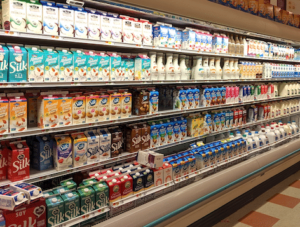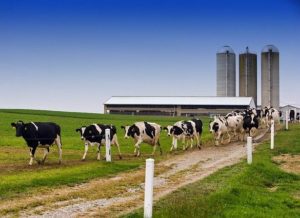
Credit: Rachel Kopay, 2019 Market Basket, Hudson, MA
Think about the last time you walked into a grocery store to buy a carton of milk. How many options awaited you in the dairy aisle? Growing up on a dairy farm, I had two options for milk, whole milk with cream on top or without (Holstein style 3.5% butterfat). It was only when I could drive that I had a third option: buying our processor’s skim milk from the grocery store.
The thought of buying “milk” that was not cow-based was never a consideration. There were no milk allergies in the family, our cows were treated with care — being regarded as the highest-ranking females on the farm — and my father implemented farming practices that we describe today as regenerative agriculture. As a family, we believed our livelihood was making a positive health impact on the lives of others and that competition for shelf space was between brands and fat content rather than other “milk” products. Now, with the advancement of technology and the constant drumbeat of environmental and health concerns about cow’s milk expressed by some, the dairy aisle is brimming with options. With the rise of plant-based milks, it may be tempting to say “move over cows” but it’s important to know the facts.
The Crowded Dairy Case
Today, the range of “milks” run the gamut from tree nut, to peanut, to a variety of plant and grain-based products. According to recent grocery sales data, the most popular plant-based milks are almond, oat, soy, coconut, pea and rice.1 Additionally, milk-like beverages produced from hemp, bananas, barley, cashews, walnuts, macadamia and chia seed also fill the refrigerated dairy case. During COVID-19, the sale of plant-based products grew as more consumers sought food products that aligned with their personal and planet health values. Plant-based milk, the largest of all the plant-based food categories, grew by 20% in 2020. With $2.5 billion being spent on these products, the category now makes up 35% of all plant-based food sales according to the Good Food Institute’s Plant-Based Retail Market Summary.2 It is estimated that plant-based milk is purchased by an estimated four in 10 families. Even though cow’s milk is still the most popular milk beverage, plant-based milk sales are projected to continue double digit growth over the next six years.3 As consumers, the plethora of “milk type” beverages provide us options to meet our various values, health or taste preferences, but we need to recognize that not all “milks” are created equally.
Beyond the “Health Halo”
Over the past few years, various consumer surveys show that plant-based food products are viewed as more healthful than animal-based foods. In a 2018 Consumer Reports Plant-Based National Survey, over half of the consumers polled believed plant-based milk had more (27%) or the same (25%) nutrients as found in cow’s milk (e.g., protein, calcium, vitamin A and potassium). Another 20% did not know. Of the consumers who said they usually or always purchase plant-based milk, 42% thought plant-based milks have a higher nutrient content than cow’s milk.4
However, perception is not reality. While cow’s milk naturally contains 11 essentials nutrients and is fortified with Vitamin A and D, the other milk-type products vary in protein and nutrient content depending on the original food source, fortification and ingredients used during the development process. Let’s take a closer look based on an 8 oz serving:1,3
- Almond Milk – The calcium and Vitamin D fortification is similar and the calories slightly lower than cow’s milk but the difference here is the protein:1 gm versus 8 gm for cow’s milk!
- Soy Milk – When fortified with calcium and Vitamin A and D, soy milk comes the closest to matching the nutritional profile of cow’s milk. With 7 gm of protein, this plant-based alternative is the only nondairy beverage recommended in the 2020–2025 Dietary Guidelines for Americans because it comes closest to matching the nutrition profile and nutrient density of cow’s milk.3
- Oat Milk – The popularity of this nondairy option has skyrocketed over the past year. With its “dairy-like” creamy texture and environmentally friendly claims, it’s taken the category by storm. Depending on the brand, the fat and calorie content is slightly lower than whole milk but higher than low-fat milk. Protein content ranges from 3-8 gm with approximately 7 grams of added sugars. Cow’s milk, like fruits or whole grains, naturally contains 12 grams of carbohydrates (lactose) but no added sugars unless it’s chocolate milk.
- Coconut Milk – This naturally sweet product provides taste without any nutrition benefits. The calorie content is the same as skim milk but has as much saturated fat as whole milk as it’s made from the grated meat of coconuts. An 8 oz serving provides only 1 gm protein and little to no other nutrients.
- Rice Milk – This nondairy product has been around for some time and was one of the few options originally available for individuals with milk allergies. However, it doesn’t stack up nutritionally. Its calorie content is similar to low-fat milk with no saturated fat but contains less than 1 gm of protein. Fortification of calcium and Vitamin D is less than cow’s milk and other nondairy beverages.
Evaluating the Trade-Offs: Personal and Planet
The benefit of technology has allowed us as consumers to have more choices about what we eat and drink. Consuming plant-based milks are an option but it’s important to know what you’re buying. From a personal health perspective, cow’s milk, followed by soy milk, will provide the best nutritional value at the best price. Scientific literature has reported in recent years of children with Vitamin D and protein deficiencies when only plant-based milks were given without additional nutritional supplementation.
 From a planet health viewpoint, there are environmental impacts regardless of the source. Dairy is often associated with a higher impact due to land use, energy costs and greenhouse gas emissions, even though the sustainability of dairy operations has improved significantly over the years.3 But, water and land sources of plant-based milks have environmental impacts as well.
From a planet health viewpoint, there are environmental impacts regardless of the source. Dairy is often associated with a higher impact due to land use, energy costs and greenhouse gas emissions, even though the sustainability of dairy operations has improved significantly over the years.3 But, water and land sources of plant-based milks have environmental impacts as well.
We Have Choices
The good news is we have choices, which allows us to make food decisions based on our own values and beliefs. At the same time, too many choices can cloud the reality of the nutrient quality of those “back to the basic” foods. Cow’s milk will continue to share space with its plant-based partners in the dairy aisle but stand alone on nutrient quality and price. For me, I’ll drink the cow’s milk and eat the oats, almonds, brown rice and soy … but we all have a choice.
References:
1. “Are Plant Based Milks Good for You?” by Dawn MacKeen, New York Times, May 10, 2021.
2. “2020 State of the Industry Report: Plant-Based Meat, Eggs and Dairy,” by The Good Food Institute
3. “Plant-Based Milks,” by Mindy Hermann, MBA, RDN, Today’s Dietitian Vol. 23, No. 5, P. 26
4. “Is Milk by Any Other Name Still Milk?” by Marianne Smith Edge, Meet Me at the Table Blog, August 30, 2019.
